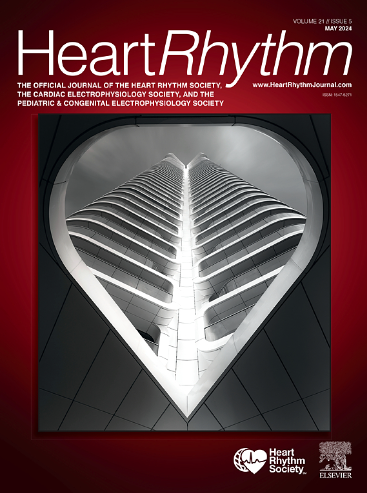Epicardial placement of implantable cardioverter-defibrillators in adults: Technical considerations, system performance, and clinical outcomes
IF 5.7
2区 医学
Q1 CARDIAC & CARDIOVASCULAR SYSTEMS
引用次数: 0
Abstract
Background
Surgical implantation of epicardial implantable cardioverter-defibrillator (ICD) is considered when transvenous ICD placement is not feasible because of congenital anomalies, venous obstruction, or prior infections. Epicardial pacemakers are well-studied but less is known about contemporary epicardial ICD systems in adults.
Objectives
This case series details the indications, techniques, safety, and long-term performance of surgically implanted epicardial high voltage (HV) coils and leads in adults.
Methods
We included all patients who received epicardial HV coils or leads at the Hospital of the University of Pennsylvania between 2014 and 2025.
Results
Nineteen patients (14 men, median age 64 years) were identified. Indications included ICD replacement after lead extraction for endocarditis (7), placement during concomitant surgery, including for tricuspid regurgitation (6), left ventricular assist device (3), and lack of venous access (3). HV coils were used in 58%, and 42% received epicardial leads. All patients received epicardial pace-sense leads; 68% received cardiac resynchronization therapy. HV coils or leads were sewn to the epicardium: 48% on the posterior left ventricle, 16% on the anterior right ventricle, 26% on both ventricles, and 11% in the transverse sinus. Two patients had impedances > 200 Ω because of a loose set screw and a damaged connector pin, respectively. Two had impedances < 20 Ω without clinical impact. One coil fractured 1.5 years post-implant. No failed shocks or lead migrations occurred. During a median follow-up of 468 days, 26% died, largely from advanced heart failure, none were attributable to surgery.
Conclusion
Surgical implantation of epicardial ICD systems with HV coils/leads is safe and feasible. Multidisciplinary planning and long-term monitoring are essential.
成人植入式心律转复除颤器心外膜放置:技术考虑、系统性能和临床结果。
背景:当由于先天性异常、静脉阻塞或既往感染而无法经静脉放置心外膜植入式心律转复除颤器(ICD)时,可考虑手术植入。心外膜起搏器研究得很好,但对成人当代心外膜ICD系统了解较少。目的:本病例系列详细介绍成人手术植入心外膜高压线圈和导线的适应症、技术、安全性和长期性能。方法:我们纳入了2014-2025年间在宾夕法尼亚大学医院接受心外膜HV线圈/导联的所有患者。结果:19例患者(男性14例,中位年龄64岁)。适应症包括心内膜炎拔铅后更换ICD(7),合并手术期间放置ICD,包括三尖瓣反流(6),左心室辅助装置(3),缺乏静脉通道(3)。58%的患者使用高压线圈,42%的患者接受心外膜导联。所有患者均接受心外膜心律导联;68%的患者接受了心脏再同步化治疗。HV线圈/导联缝在心外膜上:左后心室48%,右前心室16%,双心室26%,横窦11%。两名患者分别因固定螺钉松动和连接器引脚损坏而产生阻抗>200欧姆。结论:HV线圈/导联心外膜ICD系统手术植入是安全可行的。多学科规划和长期监测至关重要。
本文章由计算机程序翻译,如有差异,请以英文原文为准。
求助全文
约1分钟内获得全文
求助全文
来源期刊

Heart rhythm
医学-心血管系统
CiteScore
10.50
自引率
5.50%
发文量
1465
审稿时长
24 days
期刊介绍:
HeartRhythm, the official Journal of the Heart Rhythm Society and the Cardiac Electrophysiology Society, is a unique journal for fundamental discovery and clinical applicability.
HeartRhythm integrates the entire cardiac electrophysiology (EP) community from basic and clinical academic researchers, private practitioners, engineers, allied professionals, industry, and trainees, all of whom are vital and interdependent members of our EP community.
The Heart Rhythm Society is the international leader in science, education, and advocacy for cardiac arrhythmia professionals and patients, and the primary information resource on heart rhythm disorders. Its mission is to improve the care of patients by promoting research, education, and optimal health care policies and standards.
 求助内容:
求助内容: 应助结果提醒方式:
应助结果提醒方式:


